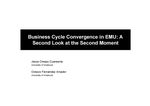Business Cycle Convergence in EMU: A Second Look at the Second Moment

Jesús Crespo-Cuaresma and Octavio Fernández-Amador
Octavio Fernández Amador (with Jesús Crespo Cuaresma)
University of Innsbruck
We analyse the dynamics of the standard deviation of business cycles across euro area countries in order to evaluate the patterns of cyclical convergence in the European Monetary Union (EMU) for the period 1960-2008. Based on SVAR models à la Blanchard and Quah (1989), we study the pattern of cyclical synchronization by applying the methodology put forward by Crespo-Cuaresma and Fernández-Amador (2009), which makes use of sigma-convergence methods to identify synchronization patterns in business cycle data. This analysis also allows us to evaluate the patterns of business cycle comovements in the EMU and compare them to the cyclical performance of the new members of the European Union (EU) and other OECD countries. Looking at demand shocks and business cycles, a more volatile behavior is detected in the measure of comovement than in results of Crespo-Cuaresma and Fernández-Amador (2009a). However, our results show a pattern of convergence during the first half of the 1990s until 1998. From then on, the economies of the euro area are less synchronized.
University of Innsbruck
We analyse the dynamics of the standard deviation of business cycles across euro area countries in order to evaluate the patterns of cyclical convergence in the European Monetary Union (EMU) for the period 1960-2008. Based on SVAR models à la Blanchard and Quah (1989), we study the pattern of cyclical synchronization by applying the methodology put forward by Crespo-Cuaresma and Fernández-Amador (2009), which makes use of sigma-convergence methods to identify synchronization patterns in business cycle data. This analysis also allows us to evaluate the patterns of business cycle comovements in the EMU and compare them to the cyclical performance of the new members of the European Union (EU) and other OECD countries. Looking at demand shocks and business cycles, a more volatile behavior is detected in the measure of comovement than in results of Crespo-Cuaresma and Fernández-Amador (2009a). However, our results show a pattern of convergence during the first half of the 1990s until 1998. From then on, the economies of the euro area are less synchronized.
Keywords: Business cycle, business cycle convergence, European Monetary Union
JEL classification: E32, E63, F02
Countries covered: European Monetary Union
Research Areas: Macroeconomic Analysis and Policy